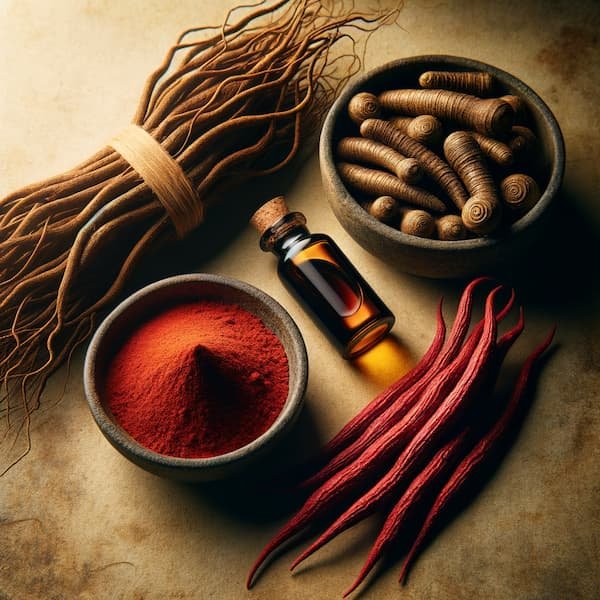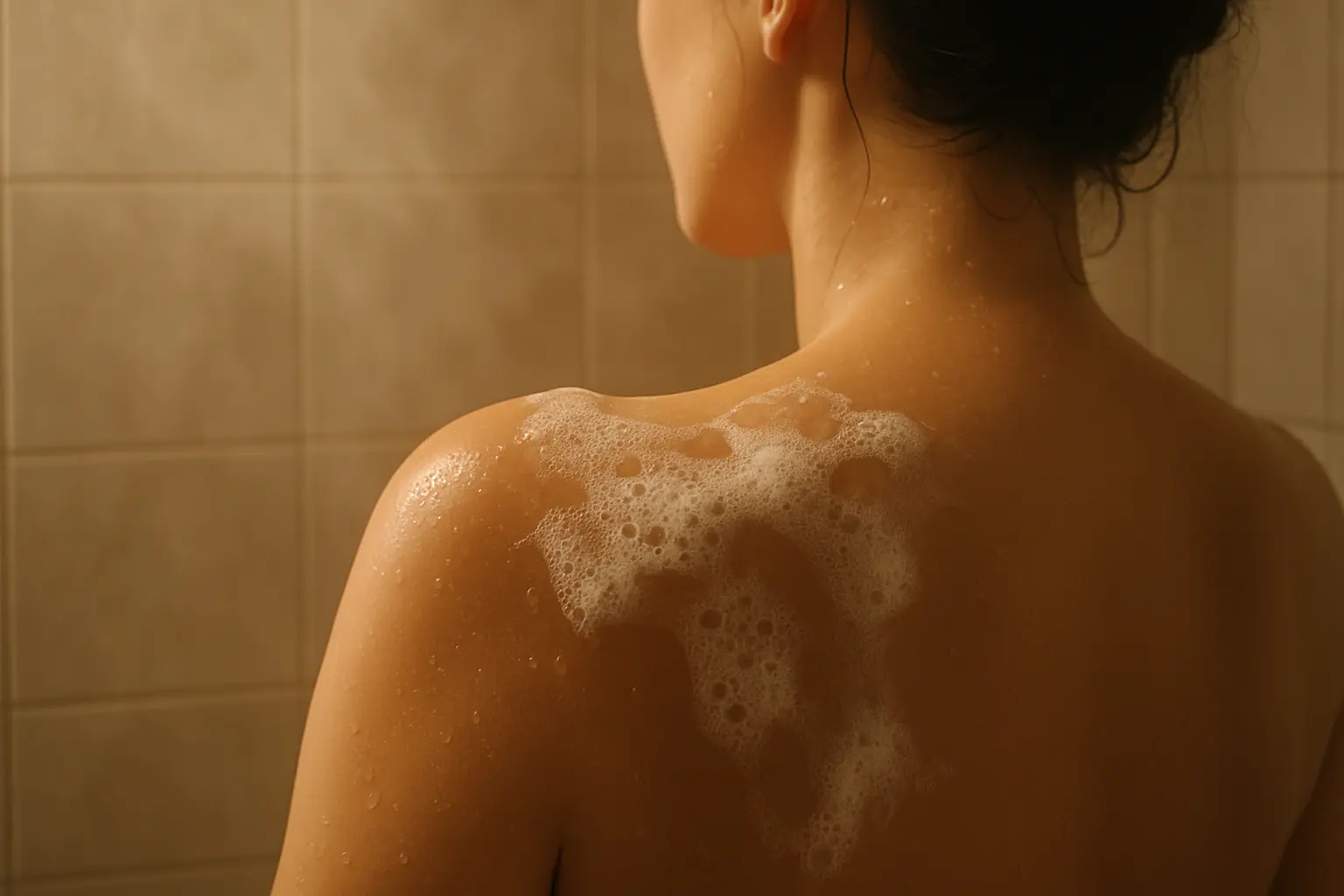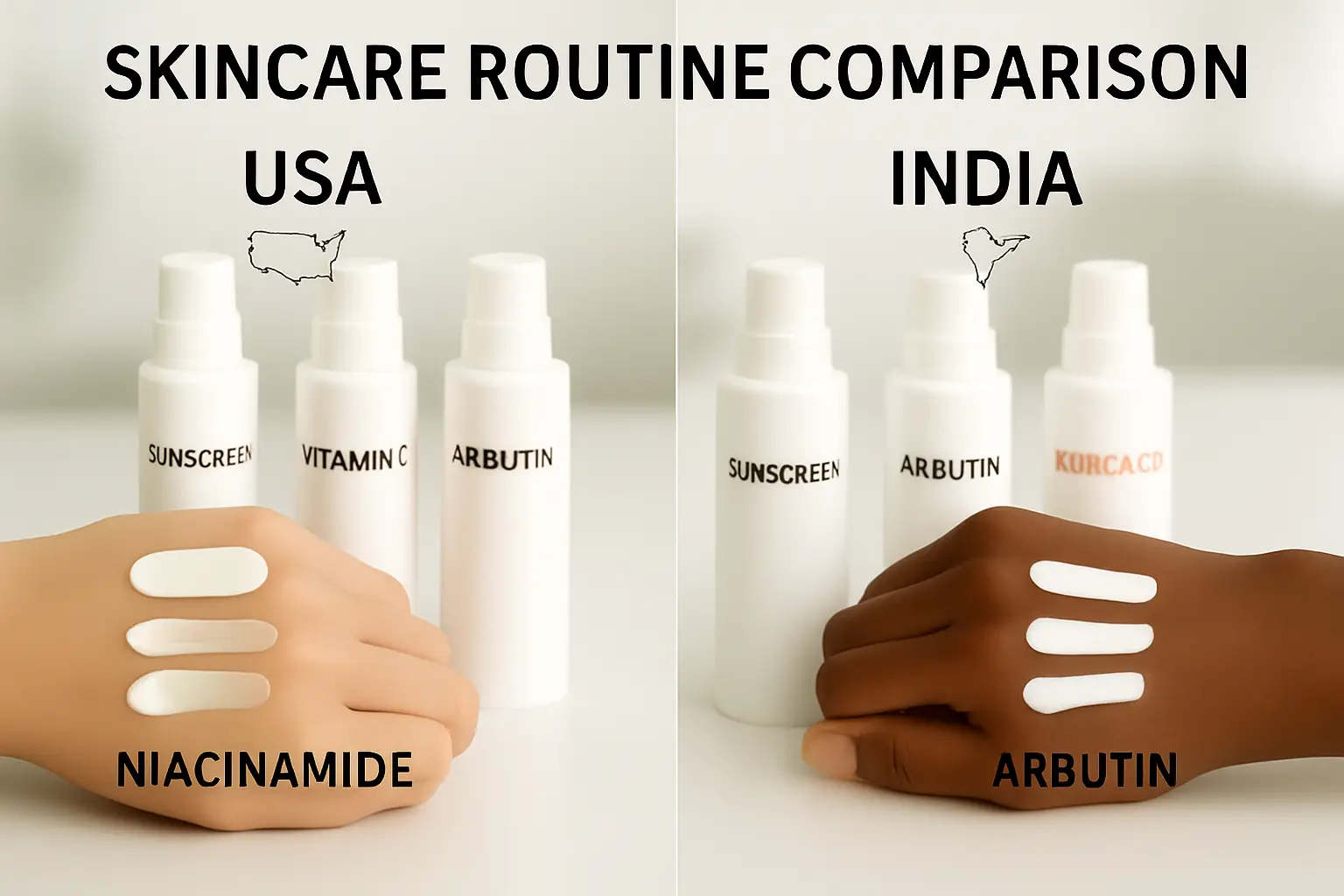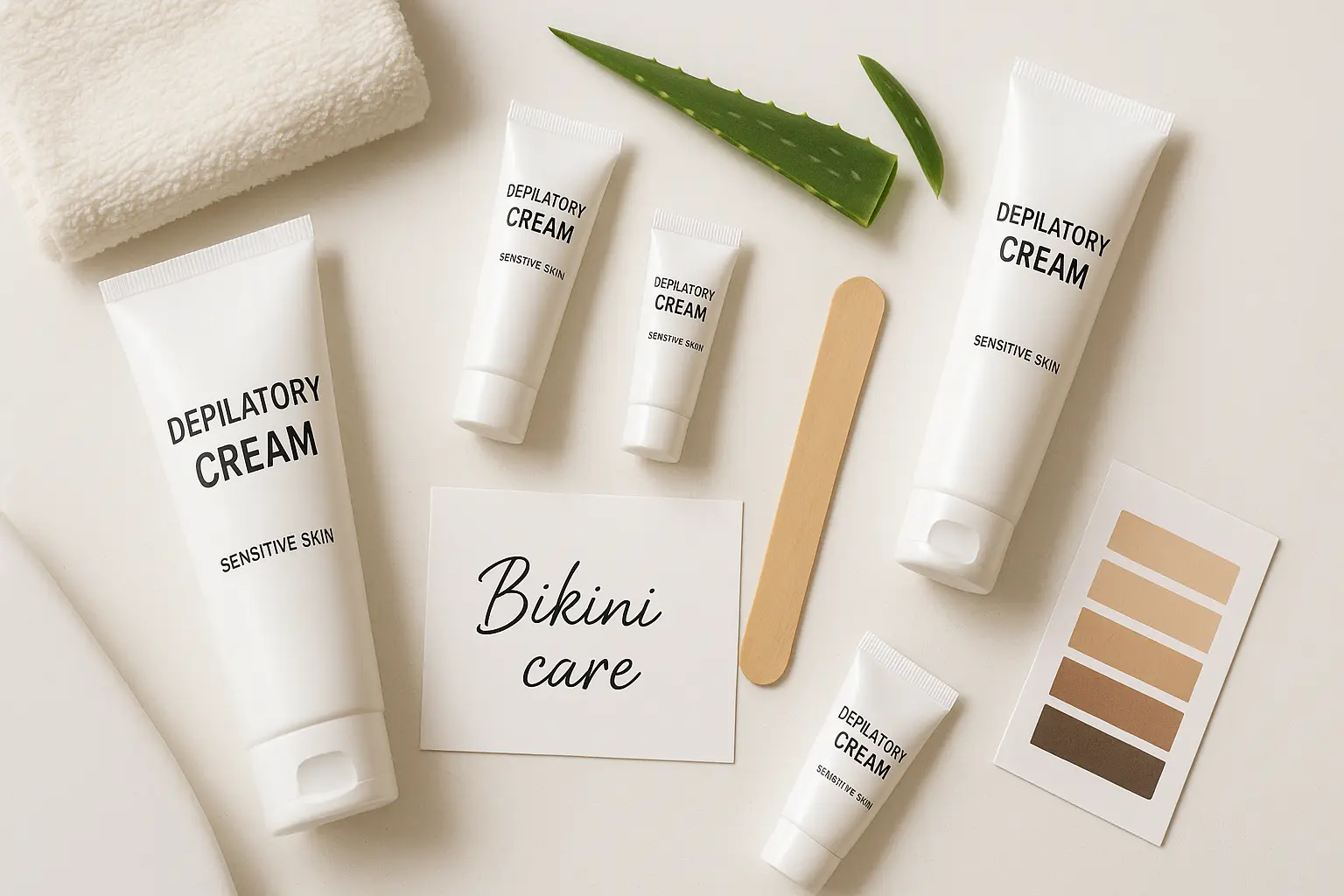Manjistha Benefits for Skin: Ultimate Glow Guide
Introduction: Why “Manjistha Benefits for Skin” Is Trending in Ayurveda
There’s a moment many people recognize—catching a glimpse in the mirror after a long, sunny day and wishing for calmer, brighter, more even-toned skin. Across India, more readers are turning to gentle, time-tested herbs to help, and that’s where Manjistha Benefits for Skin stands out. Rooted in Ayurveda, Manjistha (Rubia cordifolia) is known for complexion support, soothing inflamed skin, and promoting a healthy glow with simple routines that fit busy lives.
This guide keeps things clear and practical. It explains what Manjistha is, how it supports even tone and clarity, and the best ways to use it at home—powders, oils, masks, or modern serums—along with safety basics and realistic timelines. It also shows how to pair Manjistha with everyday skincare (like vitamin C and sunscreen) so results feel steady, not stressful. Whether someone wants help with pigmentation, post-acne marks, or dullness, this article offers an easy roadmap built for Indian weather, budgets, and routines.
Key Takeaways
- Manjistha Benefits for Skin include brighter-looking tone, calmer redness, and support for acne-prone skin when used consistently.
- Best formats: face packs (powder/ubtan), facial oils (kumkumadi tailam), and modern gels/serums with Rubia cordifolia.
- For pigmentation and dark spots, pair Manjistha with sunscreen daily and gentle actives like niacinamide or vitamin C in the morning.
- Simple routine: Manjistha-based mask 1–2 times weekly, a light moisturizer, and SPF; consider Manjistha oil or serum at night.
- Timelines: expect visible improvements in 6–12 weeks with consistent care and sun protection.
- Safety: patch-test new products; avoid over-exfoliation; consult a practitioner before internal use or if pregnant/nursing.
Manjistha 101: What It Is and Why Skin Loves It
Manjistha (Rubia cordifolia) is a classic Ayurvedic Skin Care herb prized for complexion support and overall skin harmony. In traditional texts, it’s described as a varnya herb—one that helps promote clear, bright-looking skin. The root is the part most commonly used; it contains natural compounds like anthraquinones and flavonoids that are known for antioxidant and calming properties. Put simply, Manjistha helps the skin look more even, feel soothed, and stay resilient when paired with good daily care.
Why does Manjistha fit so well into Indian skincare routines? The answer is balance. City pollution, sun exposure, and humidity can make skin look dull, uneven, or inflamed. Manjistha Benefits for Skin include support for a more even tone (especially when combined with daily SPF), comfort for redness-prone or acne-prone skin, and antioxidant backup that complements modern actives like niacinamide and vitamin C. It blends the best of two worlds: gentle Ayurvedic wisdom and today’s simple, science-informed routines.
Manjistha shows up in many formats:
- Powders for face packs/ubtans, often mixed with rose water, aloe, or yogurt.
- Classical facial oils like kumkumadi tailam where Manjistha supports glow and even tone.
- Modern serums/gels that list Rubia cordifolia extract among their key ingredients.
How it works in a routine:
- Mornings: vitamin C or niacinamide + sunscreen to protect and brighten.
- Evenings: Manjistha-based oil/serum or a weekly Manjistha pack to support clarity and calm.
- Always: sunscreen daily to prevent new dark spots and to help results last.
Bottom line: Rubia cordifolia skin benefits make Manjistha a versatile teammate—especially for pigmentation care, post-acne marks, and dullness—when used patiently and consistently alongside gentle cleansers, moisturizers, and SPF.
The Benefits Breakdown—Pigmentation, Acne, Redness, Radiance

Manjistha Benefits for Skin shine the most when tackling common concerns in India’s climate—hyperpigmentation, post-acne marks, redness, and dullness. Rooted in Ayurveda yet easy to pair with modern skincare, Manjistha supports an even, calm, radiant look when used consistently with sunscreen.
How Manjistha supports pigmentation and dark spots
- Brightening and even tone: Regular use of Manjistha (Rubia cordifolia) in face packs, oils (like kumkumadi tailam), or serums can help the look of uneven tone and dark spots over time.
- Best pairings: Use vitamin C or niacinamide in the morning and Manjistha-based products at night for a complementary routine.
- Non-negotiable: Daily SPF is essential to prevent new spots and protect results.
Acne-prone skin and post-acne marks
- Calming support: For blemish-prone skin, Manjistha can be paired with soothing allies like aloe or tulsi to reduce visible redness and help post-acne dark spots fade.
- Smart layering: Keep actives gentle—avoid mixing strong exfoliants on the same night as rich oils; use a Manjistha pack or serum on alternate evenings.
- Hygiene habits: Clean pillowcases, light gel moisturizers, and non-comedogenic sunscreen help maintain clarity.
Redness and sensitivity in heat and humidity
- Pitta-calming approach: Combine Manjistha with aloe gel or rose water for a cooling, short-contact mask in hot weather.
- Barrier-first care: Follow with a fragrance-light moisturizer to keep skin comfortable.
Radiance and daily glow
- Antioxidant routine: A simple routine—cleanse, hydrate, protect by day; calm and repair by night—lets Manjistha add radiance without overwhelming the skin.
- Inside-out synergy: Balanced meals, hydration, and sleep reinforce topical brightening.
Table: Concern-to-Routine Playbook
| Concern | How Manjistha Helps | Best Pairings | Frequency | Expected Timeline |
|---|---|---|---|---|
| Hyperpigmentation/dark spots | Supports brighter, even tone | AM vitamin C or niacinamide + daily SPF | Manjistha serum/oil PM; pack 1–2x/week | 8–12 weeks steady use |
| Post-acne marks (PIH) | Calms look of spots after breakouts | Aloe/green tea gel + sunscreen | PM Manjistha serum; gentle pack weekly | 6–10 weeks |
| Redness/sensitivity | Soothing, cooling support | Aloe/rose water; fragrance-light moisturizer | Short-contact mask 1x/week | 4–8 weeks |
| Dullness | Antioxidant glow boost | Hydrating essence + SPF | Serum/oil PM; mask every 1–2 weeks | 4–8 weeks |
How to Use Manjistha—Formats, Dosage, and Safety

Manjistha Benefits for Skin show best when it’s used in simple, consistent ways that fit daily life. Here’s how to choose the right format, use it safely, and set realistic timelines—especially for concerns like pigmentation and dark spots.
Topical Formats and How Often to Use
- Powders/ubtans: Mix manjistha powder with rose water, aloe gel, or yogurt; apply as a thin mask for 8–12 minutes; rinse and moisturize.
- Facial oils (e.g., kumkumadi tailam): Apply 2–3 drops on damp skin at night, 2–4 times a week.
- Serums/gels (Rubia cordifolia extract): Use a thin layer at night on clean, dry skin; start 3–4 nights/week, then increase if skin is comfortable.
Patch Test and Layering Basics
- Patch test: Apply a small amount along the jawline for 24–48 hours; watch for redness or stinging.
- Layering: In the morning, use vitamin C or niacinamide and always apply sunscreen; use manjistha products at night.
- Avoid mixing: Don’t pair strong acids (AHAs/BHAs) or retinoids on the same night as rich manjistha oils—alternate nights to keep skin calm.
Internal Use (Optional—Consult First)
- Formats: Capsules/decoctions are used in Ayurveda for systemic support.
- Guidance: Speak with a qualified practitioner for dosage, duration, and interactions—especially if pregnant, nursing, or on medications.
Safety and Who Should Avoid
- Sensitive skin: Start with wash-off masks before leave-on serums/oils.
- Pregnancy/lactation/medical conditions: Avoid internal use unless supervised; keep topicals simple and patch-tested.
- Over-exfoliation: Limit scrubs/acids when starting manjistha to prevent irritation.
Quick Use & Safety Table
| Format | How to Use | Frequency | Best Pairings | Avoid With |
|---|---|---|---|---|
| Manjistha powder (ubtan) | Thin mask, 8–12 min, rinse | 1–2×/week | Rose water, aloe, yogurt | Same-day strong peels |
| Manjistha facial oil (kumkumadi) | 2–3 drops on damp skin, PM | 2–4×/week | Hydrating essence, ceramides | Retinoids/acids same night |
| Manjistha serum/gel | Thin PM layer after cleanse | 3–6×/week | Niacinamide AM, SPF daily | Harsh scrubs/over-exfoliation |
| Internal (capsules/decoction) | Only under supervision | As prescribed | Balanced diet, hydration | Pregnancy, certain meds |
Routines and Recipes—At-Home Manjistha for Glow
Manjistha Benefits for Skin shine when it’s used in clear, simple routines that fit an Indian climate—heat, humidity, and sun. Below are easy AM/PM templates and three at-home recipes to target pigmentation, acne marks, redness, and dullness without overwhelming the skin.
Daily AM/PM Routine Templates
- Morning (Protect and Brighten)
- Cleanse (gentle, fragrance-light)
- Hydrating essence or aloe gel
- Vitamin C or niacinamide (pick one)
- Lightweight moisturizer (gel or lotion)
- Broad-spectrum SPF30+ (reapply outdoors)
- Evening (Calm and Repair)
- Cleanse (double cleanse only if needed)
- Optional hydrating essence
- Manjistha serum/gel or a thin layer of kumkumadi tailam (2–3 drops on damp skin)
- Moisturizer tailored to skin type
Routine Pairing Table
| Skin Concern | AM Pairing | PM Manjistha Use | Weekly Add-On | Timeline |
|---|---|---|---|---|
| Hyperpigmentation/dark spots | Vitamin C + SPF | Manjistha serum or thin kumkumadi layer | Manjistha brightening pack 1× | 8–12 weeks |
| Post-acne marks (PIH) | Niacinamide + SPF | Manjistha serum on alternate nights | Clarifying pack 1× | 6–10 weeks |
| Redness/sensitivity | Aloe gel + SPF | Short-contact manjistha mask (wash-off) | Cooling gel layer 1× | 4–8 weeks |
| Dullness | Hydrating essence + SPF | Manjistha serum most nights | Brightening pack every 2 weeks | 4–8 weeks |
DIY Recipes (Simple, India-Friendly)
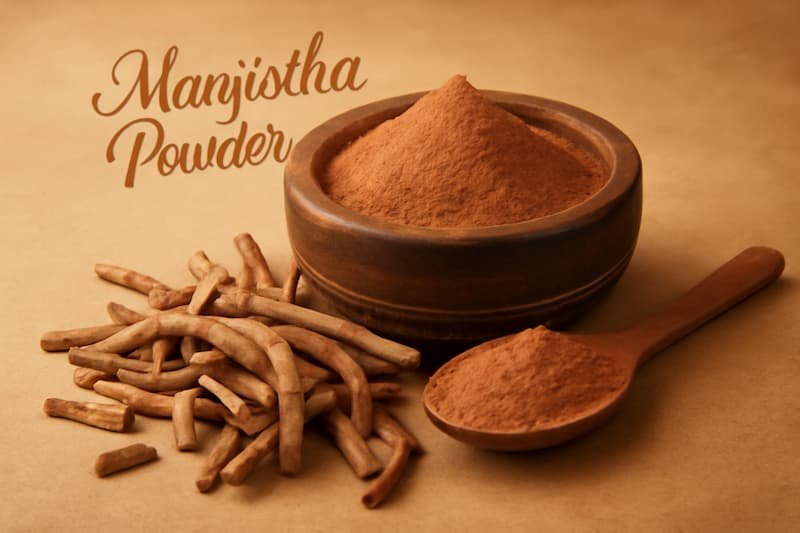
- Brightening Pack (Even Tone)
- Mix: 1 tsp manjistha powder + 1 tsp besan + rose water to a thin paste.
- Apply: 8–12 minutes; rinse; moisturize; use 1× weekly.
- Tip: Add ½ tsp yogurt if skin is dry.
- Clarifying Pack (Acne Marks)
- Mix: 1 tsp manjistha + ½ tsp neem powder + 1–2 tsp aloe gel.
- Apply: 8–10 minutes; rinse; moisturize; use 1× weekly.
- Tip: Keep contact time short if sensitive.
- Soothing Gel Layer (Heat/Redness)
- Mix: 1 tsp aloe gel + a few drops manjistha hydrosol (or rose water).
- Apply: Thin layer after cleansing; wait 2–3 minutes; then moisturizer.
- Frequency: 1–2× weekly as a calming step.
Do/Don’t Table (Results and Safety)
| Do | Don’t |
|---|---|
| Patch-test every new manjistha product/recipe | Layer with strong acids/retinoids on the same night |
| Use SPF daily to prevent new spots | Expect overnight results—go steady for 8–12 weeks |
| Keep formulas fragrance-light | Over-exfoliate in peak heat/humidity |
| Apply oils/serums on damp skin for comfort | Skip moisturizer if skin feels tight after masks |
India-Friendly Tips
- Oily/humid seasons: Prefer manjistha serums/gels over heavy oils; use gel moisturizers and gel/mineral SPF.
- Dry/AC seasons: Add a hydrating essence before manjistha oil and seal with a lotion-cream.
- Sensitive skin: Start with the wash-off brightening or clarifying pack before leave-on products.
Evidence Snapshot—Tradition Meets Modern Research
Manjistha Benefits for Skin are rooted in Ayurveda and supported by emerging modern research that highlights its calming and antioxidant potential. Traditionally, Manjistha (Rubia cordifolia) is described as a varnya herb—used to support a clear, bright-looking complexion and to balance heat and redness in the skin. In practice, it shows up in classic facial oils (like kumkumadi tailam) and in simple face packs, often paired with soothing bases such as rose water or aloe for comfort in India’s warm climate.
From a modern perspective, Rubia cordifolia contains bioactive compounds (including anthraquinones and flavonoids) that are studied for antioxidant and anti-inflammatory actions. This helps explain why it pairs well with routines targeting pigmentation, post-acne marks, and sensitivity. While more high-quality clinical trials are still needed for specific skin outcomes, the traditional use and contemporary lab findings point to a supportive role for even tone, calmness, and radiance—especially when combined with daily sunscreen and gentle skincare basics.
What this means practically is simple: Manjistha can be a helpful adjunct in routines for dark spots and redness, but it works best when layered into a complete plan—smart sun protection, consistent hydration, and patient use over 6–12 weeks. For sensitive skin, short-contact masks are a gentle way to start; for pigmentation, pair Manjistha at night with vitamin C or niacinamide in the morning.
Quick Evidence-to-Practice Table
| Insight | What it means for routine | Best use case |
|---|---|---|
| Traditional varnya (complexion support) | Add Manjistha for brightening and balance | Dullness, uneven tone |
| Antioxidant/soothing properties | Calm redness; support recovery after breakouts | Redness, post-acne marks |
| Works best with SPF and gentle care | Prevent new spots, protect results | Daily Indian sun exposure |
| Limited but growing modern evidence | Use as adjunct, not a standalone cure | Consistent use 6–12 weeks |
Product Buyer’s Guide—What to Look For
Choosing the right product makes Manjistha Benefits for Skin more consistent and comfortable—especially in India’s heat and humidity. Look for clear INCI naming, skin-type friendly textures, and simple formulas.
How to Read Labels (INCI) and Claims
- INCI naming: Look for “Rubia cordifolia,” “Manjistha extract,” or “Rubia cordifolia root extract.”
- Placement: For leave-on serums/oils, Manjistha should appear in the top or mid-ingredients to be meaningful.
- Claims to verify: “Fragrance-free” (not just “unscented”), “non-comedogenic,” and note the base oils in facial oils (sesame/coconut vs lighter squalane/jojoba).
Formats by Skin Type (India-Friendly)
- Oily/Acne-Prone: Lightweight Manjistha gel/serum; avoid heavy fragrance; pair with gel sunscreen.
- Combination: Serum most nights; thin kumkumadi layer 2–3 nights/week.
- Dry/Sensitive: Manjistha facial oil or cream with ceramides; start with short-contact masks first.
Quick Buyer’s Table (What to Look For)
| Product Type | Good Signs | Caution |
|---|---|---|
| Serum/Gel | “Rubia cordifolia extract” in top/mid INCI; fragrance-light; water-based | Strong perfumes; multiple harsh acids |
| Facial Oil (incl. kumkumadi) | Clear herb list (manjistha, saffron, licorice); light oils if acne-prone | Heavy essential oils; very occlusive bases in humid weather |
| Powder/Ubtan | Pure manjistha powder; no dyes/fragrance | Coarse texture; added synthetic colorants |
| Cream/Moisturizer | Ceramides/niacinamide; manjistha listed; non-comedogenic | Thick occlusives for oily skin; heavy scent |
Budget and Sizing Tips
- Start small: Choose minis or travel sizes to patch-test first.
- Powders are cost-effective: Great for weekly masks with rose water or aloe.
- Oils vs serums: In humid seasons, prefer serums; use oils sparingly or in AC seasons.
Simple Checklist Before Buying
- Does it list Rubia cordifolia clearly?
- Is the texture right for the current season/skin type?
- Is it fragrance-light and easy to layer with SPF?
Manjistha Benefits for Skin: FAQs
What are the main benefits of manjistha for skin?
Manjistha offers numerous benefits for skin health, including its ability to improve skin tone, reduce hyperpigmentation, and promote an even skin tone. This herb is rich in antioxidants, which help protect the skin from free radical damage, making it an effective remedy for various skin conditions.
How can I use manjistha for skin whitening?
To use manjistha for skin whitening, you can create a face pack using 1 tablespoon of manjistha powder mixed with yogurt or honey. Apply the pack to your face and neck, leave it on for 20-30 minutes, then rinse with lukewarm water. Regular use can help brighten your skin tone and reduce dark spots.
What is the best way to incorporate manjistha into my skincare routine?
The best way to incorporate manjistha into your skincare routine is by using manjistha powder or oil in your daily regimen. You can add a teaspoon of manjistha powder to your cleansers, masks, or creams, or apply manjistha oil directly to soothe irritated skin and enhance overall skin health.
Can manjistha help with acne and skin problems?
Yes, manjistha is known for its anti-inflammatory properties, making it effective in treating acne and other skin problems. Its ability to purify the blood also contributes to clearer skin, as it helps eliminate toxins that can lead to breakouts.
What are the effects of using manjistha regularly?
Regular use of manjistha can lead to revitalized skin, improved elasticity, and a reduction in signs of aging. It helps in maintaining youthful skin by promoting blood circulation and ensuring a healthy glow while evening out skin tone.
Are there any side effects of using manjistha?
Manjistha is generally safe for most skin types; however, some individuals with sensitive skin may experience irritation. It’s advisable to perform a patch test before applying it to larger areas of the skin to avoid any adverse reactions.
How does manjistha compare to other skincare ingredients?
Compared to other skincare ingredients, manjistha stands out for its natural properties and holistic benefits. Unlike chemical-based products, manjistha is an ayurvedic herb that nourishes the skin from within, helping to tackle issues like uneven skin tone and pigmentation without harsh side effects.
Can I use manjistha for treating skin conditions?
Absolutely. Manjistha is effective in treating various skin conditions such as eczema, psoriasis, and dark spots. Its soothing properties help calm irritated skin while promoting healing and rejuvenation, making it an excellent addition to your skin care regimen.
Conclusion—Your “Manjistha Benefits for Skin” Roadmap
Manjistha Benefits for Skin come to life when used simply and consistently. For most Indian skin concerns—pigmentation, post-acne marks, redness, and dullness—Manjistha works best as an adjunct: pair AM protection and brightening with PM calm and repair.
A steady plan looks like this: in the morning, cleanse, hydrate, use vitamin C or niacinamide, and finish with SPF30+; in the evening, apply a Manjistha serum/gel or a thin layer of kumkumadi tailam 2–4 nights weekly, then moisturize. Add a Manjistha face pack once a week and keep formulas fragrance-light. Expect visible improvements in 6–12 weeks, with sunscreen making the biggest difference long-term. Sensitive skin can start with a short-contact mask before leave-on products, and internal use should always be guided by a practitioner. Simple, patient habits plus daily sun protection allow Manjistha to support a calmer, more even glow.

